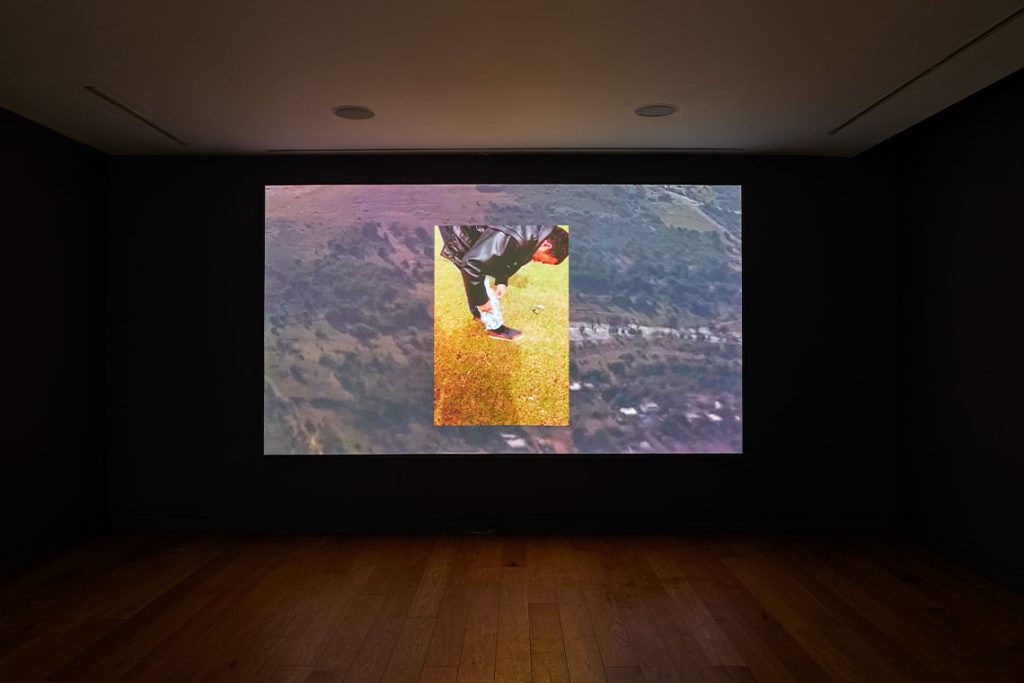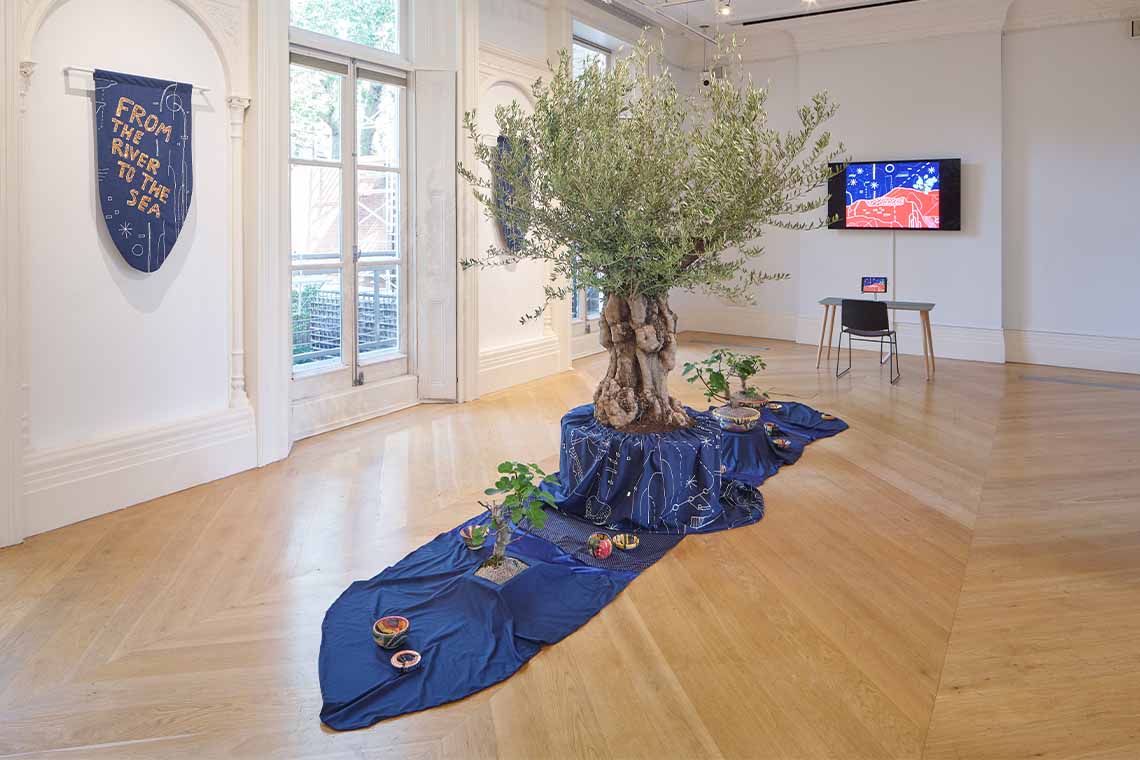The Mosaic Rooms’ latest group show In the shade of the sun, curated in conversation with Bilna’es, exhibits four of a new generation of contemporary Palestinian artists, bringing updated perspectives on a long, knotted regional history.
It is during the last throes of an oddly autumnal summer, amid the dregs of a final heatwave, that I duck into In the shade of the sun, the latest group exhibition at The Mosaic Rooms in London. In its 15th year of showcasing work from the Arab world and beyond, the gallery and cultural centre’s 2023 programme is built around “interrogating questions of active solidarity”. The aim is to identify ways of reconstructing creative support networks within the tentacled ecosystem that is the art industry – how do we work around and beyond these existing structures? How do we help and collaborate with each other better when these structures fail or hinder us?
The idea of innovating around the rigidities of an imposed system aligns well with the theme of In the shade of the sun, a show made in collaboration with Bilna’es, meaning “in the negative”, an “adisciplinary platform” and publishing space which works on finding new artist resource redistribution and support models, particularly in Palestine. Two of the collective founders of Bilna’es, Ruanne Abou-Rahme and Basel Abbas, come together curatorially with The Mosaic Rooms to exhibit four contemporary Palestinian artists – the “new generation” – bringing their dynamic mixed multimedia practices to the topic of their homeland and beyond. Broadly teasing out and entwining aesthetic and ethical propositions coming out of the region, Mona Benyamin, Xaytun Ennasr, Dina Mimi and Makimakkuk all incorporate digital technology in their works. More tellingly, the political propositions here are a given, unnecessary to spell out.

Walking straight in, I first encounter Ennasr’s installation, Revolution is a forest that the colonist can’t burn (2023). A literal tree stands in the centre of the large room, erupting sweetly out of this British wooden floor of no discernible age. It is placed atop a base wrapped in indigo fabric, flowing outwards each side to appear river-like, with living bonsais and painted ceramics on top. Behind it, a blue sash reads in bold gold glitter: FROM THE RIVER TO THE SEA. The resistive slogan ties together an already radical ouverture made by the installation’s title and tree centrepiece, evoking the olive and fig trees of Palestinian landscapes as “living sculptures”. In addition are rows of Ennasr’s drawings, each depicting different tree scenes. Poetic lines are placed under each, the text wrestling for my attention as much as the images: ‘Revolution is a sun that folds into itself, becoming shade that shelters all lovers’, ‘Revolution is the wound of a martyr that never heals’, ‘Love is a sea where no refugee drowns and corals never die’, and so on. Each phrase is at once stinging and a balm.
A firm ecocritical approach, in addition to spiritual, lyrical, material and sculptural, is an enormous strength of Ennasr’s work. The vernaculars of colonisation are rendered just as enmeshed as they actually are – encroaching capital, land, language, environment, traditions and creativity. To take one’s land is to take away its growth, Ennasr posits. That colonisation of any kind is a process involving human agents exercising destructive will, is then inverted in the work’s final element – a video game programmed and co-designed with Osama Ennasr, where, unlike usual games in which trees and forests are meant to be damaged or extracted, the player here must take care of a forest, collectively growing and nurturing it instead. Such a sharply soft conclusion to the installation, and a masterful use of technology for ecocriticism.
It is a neat segue, while still opening up further, into the themes of Dina Mimi’s installation, The melancholy of this useless afternoon (2023), located in the basement. The work is split into two single-channel videos on either side of the room, on birdsong competitions and bird smugglers. There is also a framed piece adding materiality to the work, titled Smglr91, of a cotton vest with the net and plants in which songbirds typically hide spread out upon the thin fabric. The effect, though, is of a pearlescent white coral reef slowly metastasizing across this standardised, basic garment, an effect that extends the ecocriticism of Ennasr’s work while branching into another direction. Mimi’s Chapter I is the more gripping attention-grabber, anchoring me to the bench to take in its extended use of revolutionary songs from Oman, Palestine and Yemen. They are choppy, hypnotic, tart yet melancholic, intercut with voiceover narratives of migrationary loss. The installation is altogether spare but focused, a striking rendition of the popular caged bird metaphor.

I realise on my way back up that I have missed Haifa-based Benyamin’s film Tomorrow, again (2023) at the very start of the exhibition, which, if seen first, would have significantly changed the tonal experience of the rest of the show. As I enter the nondescript door now, the first image I encounter is of an older female news anchor sobbing her makeup off “live”. She says or does nothing else, just cries. The question flits into the room: what does it look like to actually feel the daily news? My intrigue deepens, as much from the deftness with which Benyamin drives the emotional and satirical beats of a video starring her parents in various roles, demonstrating the everyday creation and consumption of endless “stories” on the quotidian violence of living in Palestine. In one parodied scene, for instance, Benyamin stages a TV news debate between the “anchor”, the “doctor”, the “lawyer” and the “political analyst”; as the anchor signals them to start, they immediately begin screaming over each other, uttering absolutely nothing intelligible.
This intelligent, acidic work lends a strong opening kick to the show as it especially flows into the softer, more abstracted elements of the installations that follow. The only shame is not being able to hear Makkimakuk’s newly commissioned sound work, tantalisingly titled What remains in the museum, purportedly on “identity, colonisation, love and relationships” and scheduled for just a single live performance. On 4 October 2023, it was announced that the Palestine-based artist had been denied a UK visa, thereby preventing her from debuting her commission and effectively participating in the show – an unfortunate, tangible interruption by the very forces the exhibition seeks to critique. Still, In the shade of the sun remains a pithy display of some of the sustained radicalism, innovation, rigour and persistence of the work coming out of a newer generation of Palestinian artists, curated with remarkable freshness.



